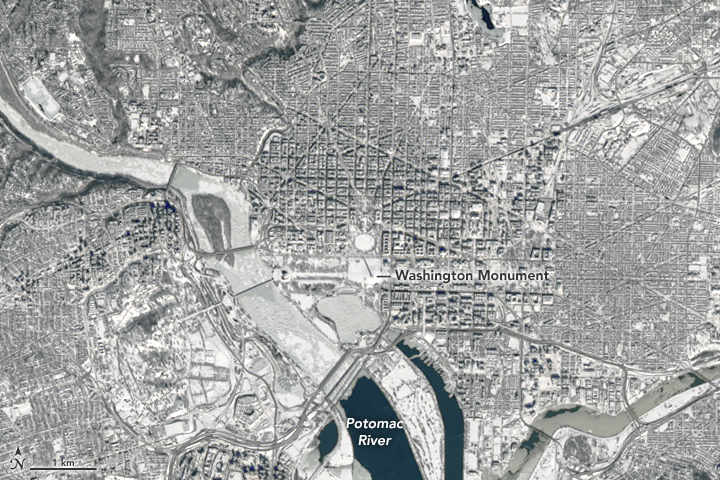

Two days after a massive winter storm system dropped snow from Tennessee and Georgia to Massachusetts, millions of Americans are digging out. By some news accounts, more than 30 million people lived in areas that received at least 20 inches (50 centimeters) of snow, and 3 million more saw at least 30 inches (75 centimeters).
The Operational Land Imager (OLI) on Landsat 8 captured this natural-color image of Virginia, Maryland, and Washington, D.C. in the early afternoon on January 24, 2016. Most neighborhoods in the image received at least 18 to 24 inches (46 to 61 centimeters) of snowfall from the nor'easter that pounded the region from January 22 to 24.
The image below is a close-up of Washington drawn from the larger image. Note the long shadow cast by the Washington Monument.

The highest snow total was recorded in Glengarry, West Virginia: 42 inches (107 centimeters). Snow totals approached records at airports near Baltimore (29.2 inches), Philadelphia (22.4 inches), and Newark, New Jersey (28.1 inches). The National Zoo in Washington, D.C. counted 22.4 inches and Central Park in New York picked up 26.8 inches.
The Moderate Resolution Imaging Spectroradiometer (MODIS) on NASA’s Aqua satellite captured a broad view of the eastern United States (below) at 1:30 p.m. Eastern Standard Time (18:30 Universal Time) on January 24, 2016.
At least 37 people have died as a result of car accidents, hypothermia, carbon monoxide poisoning, or over-exertion from shoveling snow, according to multiple news reports. At least a quarter-million people have lost electric power, and more than 13,000 airline flights have been canceled.
Beyond the snowfall, near-hurricane force winds combined with astronomically high tides to produce storm surges on the Delaware and New Jersey coasts. Sea water poured into coastal towns, while extensive beach erosion occurred as far north as Massachusetts.
Though scientific study of this blizzard has only just begun, it is possible that the strength of the storm was amplified by global warming and the record warm temperatures this year. Ocean temperatures in the North Atlantic are unusually high this winter, providing a deep well of moisture that was drawn into the storm system. Warmer air masses can carry more water to fall as snow or rain, making extreme snow events more likely even though overall annual snowfall has been dropping in recent decades.
NASA Earth Observatory images (first, second) by Joshua Stevens, using Landsat data from the U.S. Geological Survey. NASA image (third) by Jeff Schmaltz, LANCE/EOSDIS Rapid Response. Caption by Mike Carlowicz.